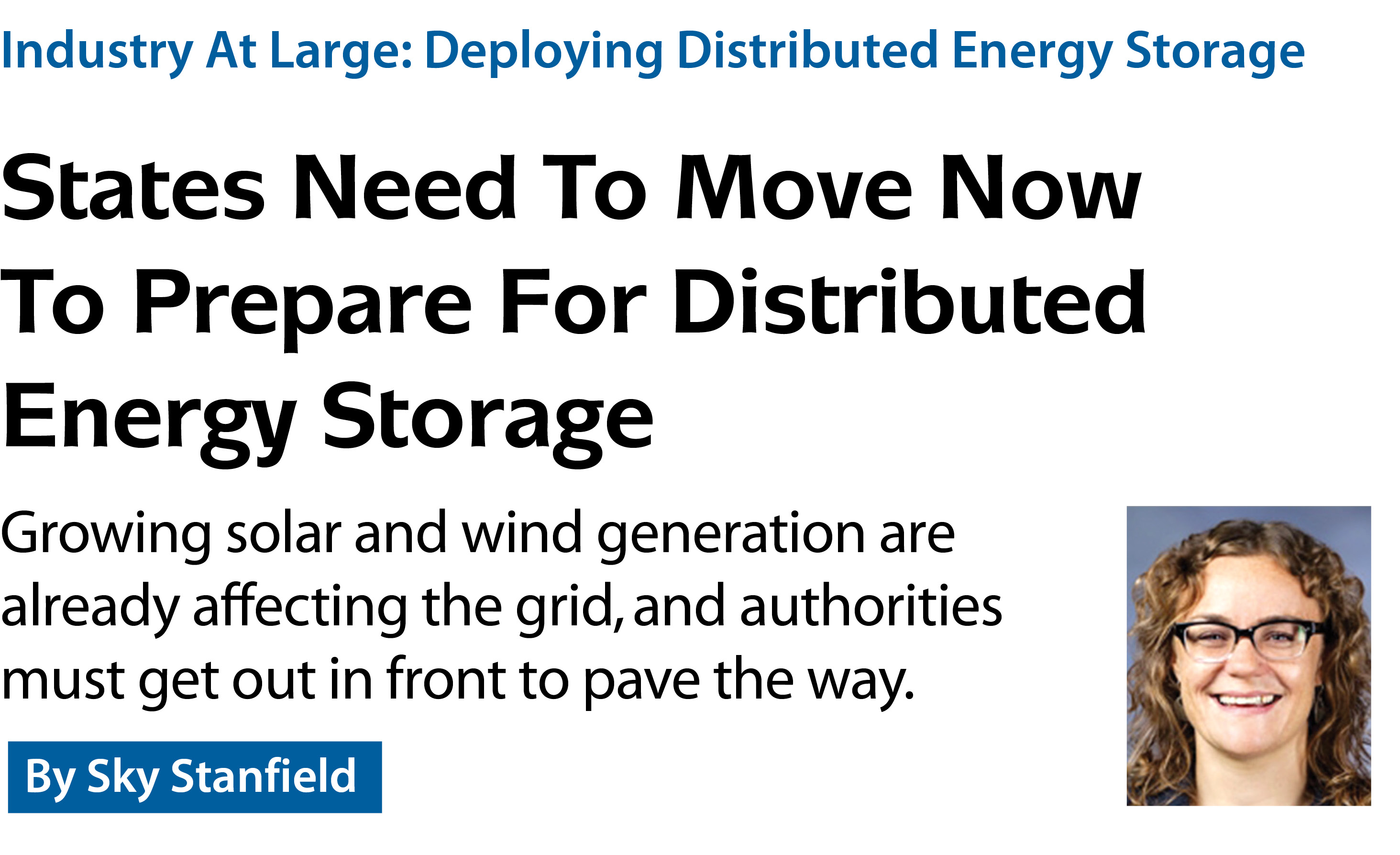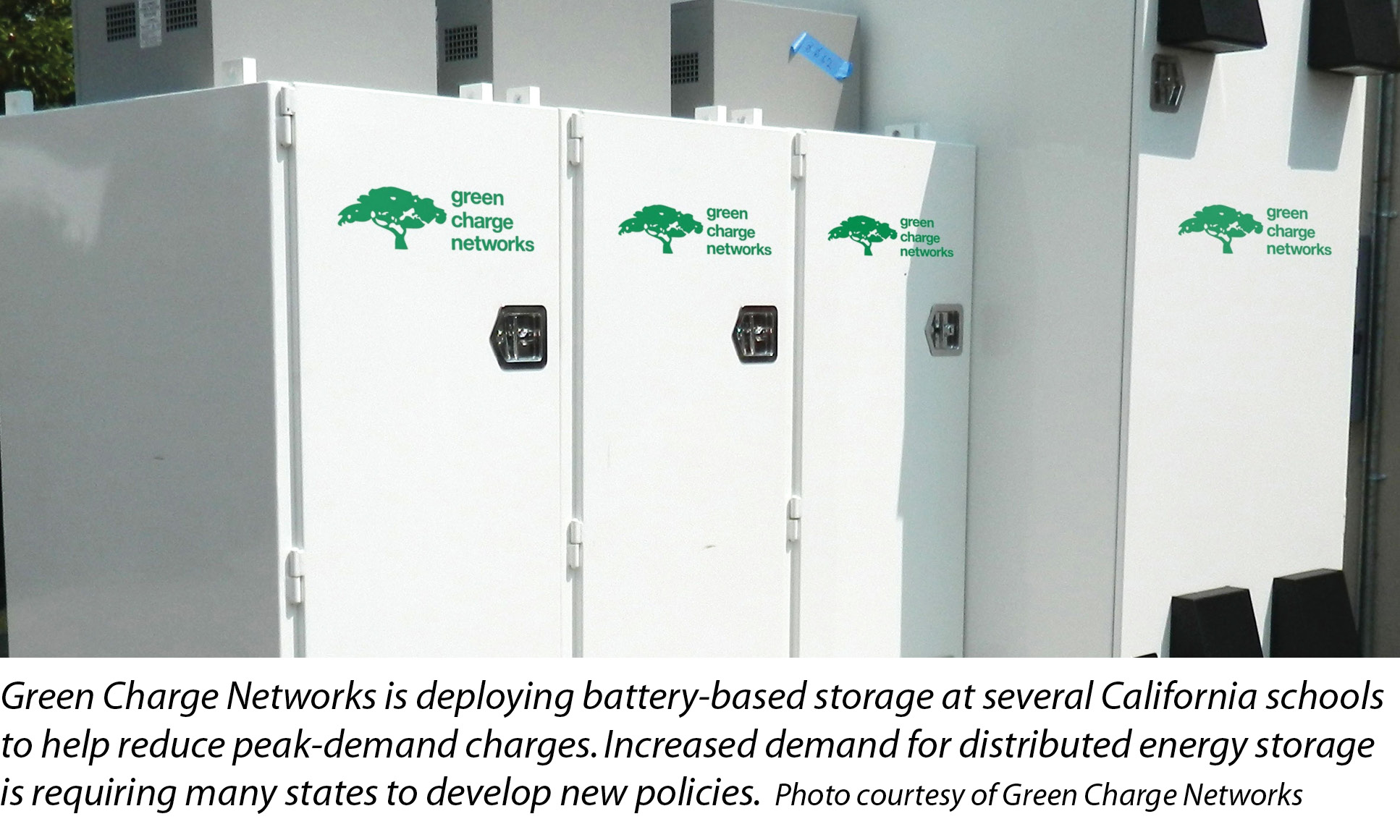

301 Moved Permanently
As the proportion of electricity generated from distributed renewable energy sources continues to grow in the U.S., particularly from solar photovoltaic systems, technologies that can facilitate their integration and expand deployment are front and center in state and national discussions.
Headlines are abundant - but not necessarily in agreement. For every article cheering the promise of new technologies, another counters with dire predictions about the challenges of integrating these new technologies and the fate of the traditional electric utility.
Rising to the fore in recent months is a dialogue about the potential of distributed energy storage. And, at this juncture, all signs seem to indicate that it’s no longer a question of whether or not storage will play a role in the near future - rather, it’s simply a question of how, when and where.
The electric system in the U.S. is undergoing a fundamental shift away from reliance on central station, base load generation that is primarily installed on the transmission system. The future electric system will rely more on variable renewable energy generation that is deployed closer to customer load on the distribution system. This shift is driven by evolving policies, consumer demand, concerns about grid resiliency, and states seeking to move away from carbon-intensive energy generation. However, the existing distribution system was not designed with two-way power flow and large amounts of variable generation in mind. Continued growth of distributed energy resources (DERs) underscores the need for proactive policies, new technologies and new techniques to smooth their integration into the electricity grid while still maintaining quality and reliable electric service.
From nearly any vantage point, distributed energy storage has enormous potential to be a vital tool for states that seek to expand the use of DERs - namely, distributed renewable energy. Distributed energy storage refers to storage systems interconnected to the utility-owned distribution system, on either the customer’s or utility’s side of the meter. Because it has the ability to address a wide range of potential issues - including renewable energy integration, variability management, peak management, voltage and frequency regulation, grid resiliency and energy management - distributed storage is gaining attention from energy customers, utilities, renewable developers and regulators alike.
Although there is widespread recognition of its potential, the market for distributed energy storage is still in its infancy. There is a significant need for regulatory guidance and proactive policies to ensure a smooth integration into the existing electrical system. A report recently released by the Interstate Renewable Energy Council (IREC) offers independent insight on how to address these new challenges - and opportunities - in the regulatory arena.
IREC’s report, “Deploying Distributed Energy Storage: Near-Term Regulatory Considerations to Maximize Benefits,” identifies six key regulatory policy considerations that states may want to consider in the near term in order to facilitate the rollout of distributed storage in a manner that captures the greatest benefits and promotes a healthy market for storage services. While a challenging issue for regulators and policymakers, the increased interest in distributed energy storage is creating the need to address the issue proactively. The states that take early steps to establish the appropriate regulatory, market and technical foundations are more likely to capture the full range of benefits, including increased consumer interest in distributed renewable energy.

Why distributed energy storage?
State and national polices combined with strong customer interest have been driving rapid increases in the use of renewable energy resources. For example, between 2003 and 2013, there were over 2,500 utility-scale solar PV systems installed in the U.S. and nearly 422,000 residential systems. These numbers are expected to continue to grow steadily in coming years. Although the aggregate capacity of the residential and small commercial systems is dwarfed by the utility-scale systems, the task of managing the large number of smaller systems on the distribution system is still considerable.
At low penetrations, issues associated with the integration of distributed renewable energy resources can likely be managed with existing grid management technologies and techniques, without the need for significant regulatory changes. As penetration grows, however, utilities and regulators will need to more proactively manage the impacts of variability and minimize the costs of integration in order to maximize the benefits of distributed renewable energy. Energy storage applications are well suited to address most of the challenges associated with distributed renewable integration - although the cost of these applications varies.
Distributed energy storage systems can assist in the management of renewables variability in a variety of ways. They can be deployed at a customer’s site or on the distribution grid to supply power or store power during periods of weather variability. They can be used to help manage frequency and voltage on the distribution system. Critically, they can also help with peak load management on the electric system. Whereas solar generation is relatively coincident with peak usage (i.e., solar systems generate power during the day, when the demand is high), there is a period in the late afternoon and evening hours when solar generation begins to ramp down - and wind generation generally only begins to ramp up - when the greatest energy demand increasingly occurs. The peak may shift even more toward the evening hours, as greater amounts of renewable energy displace load during the daytime hours. Energy storage systems have the ability to store excess renewable energy generated during non-peak hours and utilize that power to generate electricity later.
In addition to playing a role in helping states achieve their carbon-reduction goals on the electric system through integration of higher amounts of renewable energy - distributed energy storage is also being viewed as a critical piece in climate adaptation strategies that seek to enhance the ability of the electric system to withstand increasingly severe weather events. Energy storage systems can be key components of microgrids that are able to operate independently from the larger electrical system during blackouts or for other purposes. In addition, customers who install storage paired with a generator - such as PV or wind - are able to utilize their storage system to provide continuous backup power during system outages.
Another driving force behind the interest in distributed energy storage is the growing role of the customer in energy generation and management. Until recently, only a limited segment of utility customers - generally industrial and large, commercial customers - invested significantly in tools and infrastructure to help manage their energy use. The increased awareness of energy efficiency and demand response programs, the drop in prices for solar PV, the growth in financing mechanisms, the availability of net-metering programs and the variety of different incentives offered for customer-sited renewable energy have allowed a whole new range of customers to become more active managers of their energy use. These factors have created a growing segment of customers who are considering how energy storage located on their side of the meter may assist them in lowering their electricity bills.
What steps are states taking?
Solar PV’s impressive market growth is partly due to significant advancements in technologies and innovations in manufacturing, along with new business models, incentives and financing mechanisms. Yet, perhaps the most significant contributors to this market evolution are the regulatory and policy innovations in the electricity sector that have spurred the adoption of solar PV and other renewable energy technologies. Now, state policymakers and regulators are similarly beginning to focus on the importance of distributed energy storage and are using a variety of different approaches to begin aligning policies and opening markets to enable energy storage to play a significant role in the electricity system in the coming years.
Some states are just beginning to demonstrate an interest in energy storage and have begun taking exploratory steps to evaluate the potential costs, benefits, functions and regulatory needs. States with higher penetrations of distributed generation are going further, working to clarify and amend interconnection and net-metering regulations to address storage. Others have begun to move beyond just exploration and have elected to provide direct stimulus in order to help facilitate the growth of the market.
To date, California is the only state to require the regulated utilities to procure energy storage. But numerous other states, such as New Jersey, Massachusetts and Hawaii, are beginning to consider a variety of other regulatory changes that will help facilitate the use of energy storage going forward.
In light of the diversity of approaches and the variety of different issues and opportunities that energy storage integration presents, IREC’s report seeks to assist regulators in identifying some of the most important near-term steps to help facilitate growth in distributed energy storage. IREC has identified six key considerations for regulators as they evaluate distributed energy storage in their state.
Specifically, regulators may consider the following:
- Designing rate structures that send economic signals to energy storage customers in order to encourage them to operate their system in a manner that benefits the electric grid and the customer;
- Creating or modifying markets for ancillary services and demand response to enable energy storage customers to offer those services, either individually, or in the aggregate;
- Updating interconnection standards to ensure that energy storage systems have fair and efficient access to the electrical grid;
- Clarifying eligibility rules for net-metering programs to maintain integrity of those programs while also allowing storage systems to participate;
- Implementing a broader scope for distribution system planning and management than has been seen historically to create an electrical system that fully takes advantage of the benefits of energy storage when deployed with other distributed energy resources; and
- Coordinating oversight of energy storage systems with other governmental authorities in order to ensure safety without imposing duplicative or conflicting regulatory requirements.
Although not all of these actions are going to be necessary in every state, the information presented in the report demonstrates that there is a need for regulators to take conscious steps to clarify and improve regulations and market conditions for energy storage in order to capture the greatest benefits and to avoid market interruptions. In addition, a predictable and standardized regulatory policy environment is imperative to expedite the transition to a more efficient, low-carbon electric grid that offers improved service to customers and enables greater penetrations of DERs on the system.
The renewable energy market has taken off much faster than most would have predicted and, in some cases, has left states scrambling to respond to customer demands and utility concerns. At the same time, many states have been able to keep markets moving with a continued focus on policy adaptations and innovations. Inherent in this process is a learning curve, but it is a learning curve that does not have to be faced alone.
State regulators are beginning to explore and take initial steps to address some of the immediate barriers, but best practices have yet to emerge. With the information and recommendations presented in “Deploying Distributed Energy Storage: Near-Term Regulatory Considerations to Maximize Benefits,” IREC hopes to aid regulators and policymakers as they work to identify the steps that need to be taken in the early stages of addressing the promise - and the challenge - of an accelerating deployment of distributed energy storage. As states begin to take action, IREC will continue to keep stakeholders and regulators informed about the lessons learned and will help to identify best practices as they emerge, easing the learning curve.
For more information on IREC’s report, “Deploying Distributed Energy Storage: Near-Term Regulatory Considerations to Maximize Benefits,” go to www.irecusa.org.
Industry At Large: Deploying Distributed Energy Storage
States Need To Move Now To Prepare For Distributed Energy Storage
By Sky Stanfield
Growing solar and wind generation are already affecting the grid, and authorities must get out in front to pave the way.
si body si body i si body bi si body b
si depbio
- si bullets
si sh
si subhead
pullquote
si first graph
si sh no rule
si last graph